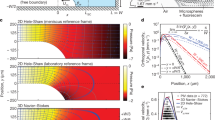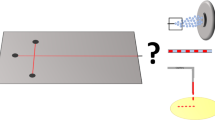Abstract
Microfluidics is flourishing due to its significant applications in life sciences and biomedical engineering. One of the key challenges in microfluidics is the manipulation and control of fluids within microscale channels. Capillary force-driven flows provide a potential solution to this challenge by eliminating the need for an external power source. Capillary force-driven flows are particularly useful for the reproducible and reliable quantitative analysis of single-molecule DNA. We have designed several microfluidic devices that employ capillary force to enhance the deposition of DNA molecules onto a positively charged glass surface from a sample solution. The optimization of specific dimensions within the microfluidic device resulted in increased efficiency of DNA deposition. Shortening the microchannel length reduced flow resistance and decreasing the microchannel height enhanced capillary force. Additionally, increasing the outlet reservoir capacity achieves mechanical equilibrium in situations where fluid flow is maximized. These optimizations served to maximize capillary force and improve DNA deposition on the glass surface. The developed device represents an ultra-sensitive platform for quantitative DNA analysis and rapid, accurate point-of-care testing with a minimum detection limit achieved. In conclusion, our work demonstrates the potential of capillary force-driven microfluidics for the reproducible and efficient manipulation of fluids within microscale channels.





Similar content being viewed by others
References
Tseng, Q., Lomonosov, A.M., Furlong, E.E.M., Merten, C.A.: Fragmentation of DNA in a sub-microliter microfluidic sonication device. Lab Chip 12, 4677–4682 (2012)
McClain, M.A., et al.: Microfluidic devices for the high-throughput chemical analysis of cells. Anal. Chem. 75, 5646–5655 (2003)
Tehranirokh, M., Kouzani, A.Z., Francis, P.S., Kanwar, J.R.: Microfluidic devices for cell cultivation and proliferation. Biomicrofluidics 7, 51502 (2013)
Beauchamp, M.J., Gong, H., Woolley, A.T., Nordin, G.P.: 3D printed microfluidic features using dose control in X, Y, and Z dimensions. Micromachines (Basel) 9, 326 (2018)
Hansen, C.L., Classen, S., Berger, J.M., Quake, S.R.: A microfluidic device for kinetic optimization of protein crystallization and in situ structure determination. J. Am. Chem. Soc. 128, 3142–3143 (2006)
Selmi, M., Gazzah, M.H., Belmabrouk, H.: Optimization of microfluidic biosensor efficiency by means of fluid flow engineering. Sci. Rep. 7, 1–11 (2017)
Lee, S., Kim, J.H., Kang, S.J., Chang, I.H., Park, J.Y.: Customized multilayered tissue-on-a-chip (MToC) to simulate Bacillus Calmette-Guérin (BCG) immunotherapy for bladder cancer treatment. BioChip J. 16, 67–81 (2022)
Crevillén, A.G., Hervás, M., López, M.A., González, M.C., Escarpa, A.: Real sample analysis on microfluidic devices. Talanta 74, 342–357 (2007)
Horsman, K.M., Bienvenue, J.M., Blasier, K.R., Landers, J.P.: Forensic DNA analysis on microfluidic devices: a review. J. Forensic Sci. 52, 784–799 (2007)
Wheeler, A.R., et al.: Microfluidic device for single-cell analysis. Anal. Chem. 75, 3581–3586 (2003)
Wang, R., Wang, X.: Sensing of inorganic ions in microfluidic devices. Sens. Actuat. B Chem. 329, 129171 (2021)
Huyen, L.T.N., et al.: Flexible capillary microfluidic devices based on surface-energy modified polydimethylsiloxane and polymethylmethacrylate with room-temperature chemical bonding. BioChip J. 17, 120–132 (2023)
Becker, H., Locascio, L.E.: Polymer microfluidic devices. Talanta 56, 267–287 (2002)
Yeo, L.Y., Chang, H.-C., Chan, P.P.Y., Friend, J.R.: Microfluidic devices for bioapplications. Small 7, 12–48 (2011)
Niculescu, A.-G., Chircov, C., Bîrcă, A.C., Grumezescu, A.M.: Fabrication and applications of microfluidic devices: a review. Int. J. Mol. Sci. 22, 2011 (2021)
Na, H., Kang, B.H., Ku, J., Kim, Y., Jeong, K.H.: On-chip paper electrophoresis for ultrafast screening of infectious diseases. BioChip J. 15, 305–311 (2021)
Stone, H.A., Kim, S.: Microfluidics: basic issues, applications, and challenges. AIChE J. 47, 1250–1254 (2001)
Bruus, H. Theoretical microfluidics (2008)
Battat, S., Weitz, D.A., Whitesides, G.M.: An outlook on microfluidics: the promise and the challenge. Lab Chip 22, 530–536 (2022)
Kawamata, T., Yamada, M., Yasuda, M., Seki, M.: Continuous and precise particle separation by electroosmotic flow control in microfluidic devices. Electrophoresis 29, 1423–1430 (2008)
Jo, K., Chen, Y.-L., de Pablo, J.J., Schwartz, D.C.: Elongation and migration of single DNA molecules in microchannels using oscillatory shear flows. Lab Chip 9, 2348–2355 (2009)
Horiuchi, K., Dutta, P.: Electrokinetic flow control in microfluidic chips using a field-effect transistor. Lab Chip 6, 714–723 (2006)
Jo, K., et al.: Mass spectrometric imaging of peptide release from neuronal cells within microfluidic devices. Lab Chip 7, 1454–1460 (2007)
Zeng, W., Jacobi, I., Beck, D.J., Li, S., Stone, H.A.: Characterization of syringe-pump-driven induced pressure fluctuations in elastic microchannels. Lab Chip 15, 1110–1115 (2015)
Parittotokkaporn, S., et al.: Make it simple: long-term stable gradient generation in a microfluidic microdevice. Biomed. Microdev. 21, 77 (2019)
Harrison, D.J., Manz, A., Fan, Z.H., Luedi, H., Widmer, H.M.: Capillary electrophoresis and sample injection systems integrated on a planar glass chip. Anal. Chem. 64, 1926–1932 (1992)
Harrison, D.J., et al.: Micromachining a miniaturized capillary electrophoresis-based chemical analysis system on a chip. Science 261, 895–897 (1993)
Jo, K., et al.: A single-molecule barcoding system using nanoslits for DNA analysis. Proc. Natl. Acad. Sci. 104, 2673–2678 (2007)
Kim, Y., et al.: Nanochannel confinement: DNA stretch approaching full contour length. Lab Chip 11, 1721–1729 (2011)
Lee, S., et al.: Nanochannel-confined TAMRA-polypyrrole stained DNA stretching by varying the ionic strength from micromolar to millimolar concentrations. Polymers 11, 15 (2019)
Delamarche, E., et al.: Microfluidic networks for chemical patterning of substrates: design and application to bioassays. J. Am. Chem. Soc. 120, 500–508 (1998)
Dimalanta, E.T., et al.: A microfluidic system for large DNA molecule arrays. Anal Chem 76, 5293–5301 (2004)
Kim, T., et al.: Counting DNA molecules on a microchannel surface for quantitative analysis. Talanta 252, 123826 (2023)
Shrewsbury, P., Muller, S., Liepmann, D.: Characterization of DNA flow through microchannels. In: Technical Proceedings of the 1999 International Conference on Modeling and Simulation of Microsystems: Chpt Vol. 16 (Citeseer, 1999)
Teixeira, R.E., Babcock, H.P., Shaqfeh, E.S.G., Chu, S.: Shear thinning and tumbling dynamics of single polymers in the flow-gradient plane. Macromolecules 38, 581–592 (2005)
Socol, M., et al.: Contraction and tumbling dynamics of DNA in shear flows under confinement induced by transverse viscoelastic forces. Macromolecules 52, 1843–1852 (2019)
Günther, K., Mertig, M., Seidel, R.: Mechanical and structural properties of YOYO-1 complexed DNA. Nucleic Acids Res 38, 6526–6532 (2010)
Bong, S., et al.: AT-specific DNA visualization revisits the directionality of bacteriophage λ DNA ejection. Nucleic Acids Res 51, 5634–5646 (2023)
Chen, Y.L., Graham, M.D., de Pablo, J.J., Jo, K., Schwartz, D.C.: DNA molecules in microfluidic oscillatory flow. Macromolecules 38, 6680–6687 (2005)
Bruus, H.: Theoretical microfluidics. Oxford University Press, Oxford (2007)
Olanrewaju, A., Beaugrand, M., Yafia, M., Juncker, D.: Capillary microfluidics in microchannels: from microfluidic networks to capillaric circuits. Lab Chip 18, 2323–2347 (2018)
Marko, J.F., Siggia, E.D.: Stretching DNA. Macromolecules 28, 8759–8770 (1995)
Robertson, R.M., Laib, S., Smith, D.E.: Diffusion of isolated DNA molecules: dependence on length and topology. Proc Natl Acad Sci U S A 103, 7310–7314 (2006)
Choi, S.: Powering point-of-care diagnostic devices. Biotechnol. Adv. 34, 321–330 (2016)
Acknowledgements
This work was supported by the National Research Foundation of Korea (NRF) grant NRF-2016R1A6A1A03012845, and RS-2023-00245053. The grammar and expression of the manuscript was corrected using ChatGPT.
Author information
Authors and Affiliations
Corresponding author
Ethics declarations
Conflict of Interest
The authors declare no competing financial interests.
Additional information
Publisher's Note
Springer Nature remains neutral with regard to jurisdictional claims in published maps and institutional affiliations.
Rights and permissions
Springer Nature or its licensor (e.g. a society or other partner) holds exclusive rights to this article under a publishing agreement with the author(s) or other rightsholder(s); author self-archiving of the accepted manuscript version of this article is solely governed by the terms of such publishing agreement and applicable law.
About this article
Cite this article
Kim, T., Jo, K. Microfluidic Device to Maximize Capillary Force Driven Flows for Quantitative Single-Molecule DNA Analysis. BioChip J 17, 384–392 (2023). https://doi.org/10.1007/s13206-023-00115-1
Received:
Revised:
Accepted:
Published:
Issue Date:
DOI: https://doi.org/10.1007/s13206-023-00115-1




